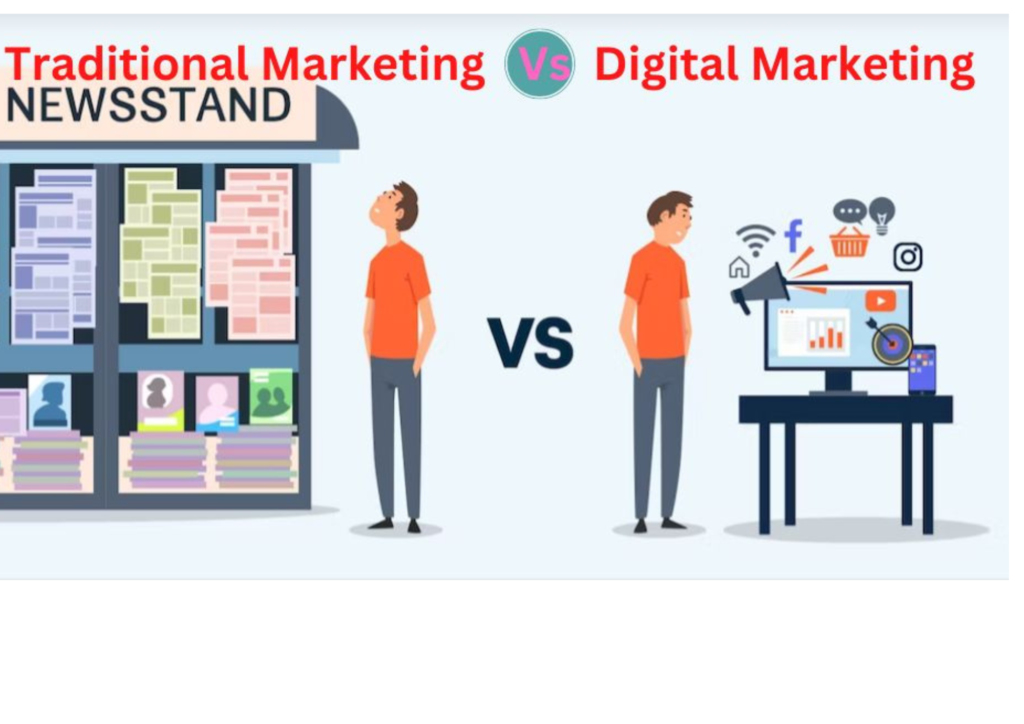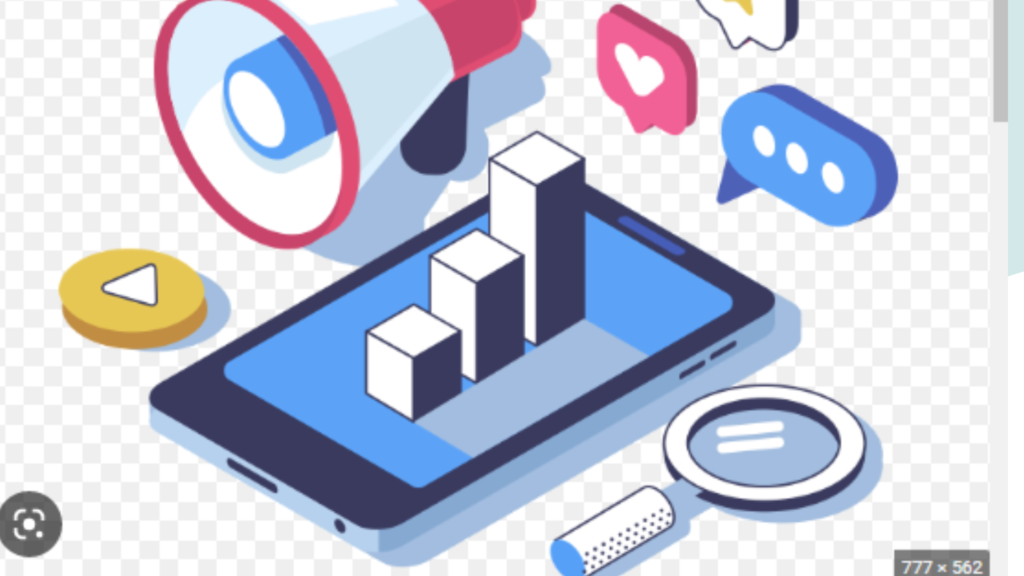Digital Marketing vs Traditonal Marketing

Digital marketing refers to the use of online platforms, digital channels, and electronic devices to promote products, services, brands, or businesses to a target audience. It encompasses a wide range of tactics and strategies designed to reach and engage customers through digital means. Here’s a detailed breakdown:
Channels of Digital Marketing:
Search Engine Optimization (SEO): Enhancing the visibility of a website on search engines like Google through organic (non-paid) search results.
Content Marketing: Creating and distributing valuable, relevant content (like blog posts, videos, and infographics) to attract and engage a target audience.
Social Media Marketing: Utilizing social media platforms (like Facebook, Instagram, Twitter, LinkedIn) to promote products, engage with customers, and build brand awareness.
Email Marketing: Sending targeted emails to prospects and customers to promote products, share news, or nurture relationships.
Pay-Per-Click (PPC) Advertising: Paid advertisements on search engines (Google Ads) or social media (Facebook Ads) where advertisers pay a fee each time their ad is clicked.
Affiliate Marketing: Promoting products or services through affiliates (partners) who earn a commission for each sale or lead generated.
Influencer Marketing: Collaborating with influencers to promote products to their followers on social media and other digital platforms.
Display Advertising: Banner ads and other visual advertisements on websites, apps, or social media.
Video Marketing: Creating and sharing videos on platforms like YouTube, or embedding them in websites to promote products or engage customers.
Search Engine Optimization (SEO): Enhancing the visibility of a website on search engines like Google through organic (non-paid) search results.
Content Marketing: Creating and distributing valuable, relevant content (like blog posts, videos, and infographics) to attract and engage a target audience.
Social Media Marketing: Utilizing social media platforms (like Facebook, Instagram, Twitter, LinkedIn) to promote products, engage with customers, and build brand awareness.
Email Marketing: Sending targeted emails to prospects and customers to promote products, share news, or nurture relationships.
Pay-Per-Click (PPC) Advertising: Paid advertisements on search engines (Google Ads) or social media (Facebook Ads) where advertisers pay a fee each time their ad is clicked.
Affiliate Marketing: Promoting products or services through affiliates (partners) who earn a commission for each sale or lead generated.
Influencer Marketing: Collaborating with influencers to promote products to their followers on social media and other digital platforms.
Display Advertising: Banner ads and other visual advertisements on websites, apps, or social media.
Video Marketing: Creating and sharing videos on platforms like YouTube, or embedding them in websites to promote products or engage customers.
Search Engine Optimization (SEO): Enhancing the visibility of a website on search engines like Google through organic (non-paid) search results.
Content Marketing: Creating and distributing valuable, relevant content (like blog posts, videos, and infographics) to attract and engage a target audience.
Social Media Marketing: Utilizing social media platforms (like Facebook, Instagram, Twitter, LinkedIn) to promote products, engage with customers, and build brand awareness.
Email Marketing: Sending targeted emails to prospects and customers to promote products, share news, or nurture relationships.
Pay-Per-Click (PPC) Advertising: Paid advertisements on search engines (Google Ads) or social media (Facebook Ads) where advertisers pay a fee each time their ad is clicked.
Affiliate Marketing: Promoting products or services through affiliates (partners) who earn a commission for each sale or lead generated.
Influencer Marketing: Collaborating with influencers to promote products to their followers on social media and other digital platforms.
Display Advertising: Banner ads and other visual advertisements on websites, apps, or social media.
Video Marketing: Creating and sharing videos on platforms like YouTube, or embedding them in websites to promote products or engage customers.
Search Engine Optimization (SEO): Enhancing the visibility of a website on search engines like Google through organic (non-paid) search results.
Content Marketing: Creating and distributing valuable, relevant content (like blog posts, videos, and infographics) to attract and engage a target audience.
Social Media Marketing: Utilizing social media platforms (like Facebook, Instagram, Twitter, LinkedIn) to promote products, engage with customers, and build brand awareness.
Email Marketing: Sending targeted emails to prospects and customers to promote products, share news, or nurture relationships.
Pay-Per-Click (PPC) Advertising: Paid advertisements on search engines (Google Ads) or social media (Facebook Ads) where advertisers pay a fee each time their ad is clicked.
Affiliate Marketing: Promoting products or services through affiliates (partners) who earn a commission for each sale or lead generated.
Influencer Marketing: Collaborating with influencers to promote products to their followers on social media and other digital platforms.
Display Advertising: Banner ads and other visual advertisements on websites, apps, or social media.
Video Marketing: Creating and sharing videos on platforms like YouTube, or embedding them in websites to promote products or engage customers.
Mobile Marketing: Reaching customers through mobile devices via SMS, in-app advertising, or mobile-optimized websites and apps.
Mobile Marketing: Reaching customers through mobile devices via SMS, in-app advertising, or mobile-optimized websites and apps.
Mobile Marketing: Reaching customers through mobile devices via SMS, in-app advertising, or mobile-optimized websites and apps.
Mobile Marketing: Reaching customers through mobile devices via SMS, in-app advertising, or mobile-optimized websites and apps.
Key Components of Digital Marketing:
Content marketing image

Website: A central hub for most digital marketing activities where potential customers can learn more about products and services.
Analytics: Tools like Google Analytics that provide insights into user behavior, campaign performance, and ROI (Return on Investment).
CRM (Customer Relationship Management): Software that helps manage interactions with current and potential customers, track data, and automate sales processes.
Automation: Technologies and platforms that streamline repetitive tasks (like email campaigns) and improve efficiency.
Content Management Systems (CMS): Platforms like WordPress that facilitate the creation, management, and modification of digital content.
3. Benefits of Digital Marketing:
Global Reach: Ability to reach a global audience without geographical limitations.
Cost-Effectiveness: Often more affordable than traditional marketing methods.
Measurable Results: Easy to track and measure campaign performance with precise data.
Personalization: Ability to tailor messages and offers to specific audiences based on data.
Engagement: Opportunities for real-time interaction and engagement with customers.
4. Digital Marketing Strategies:
Inbound Marketing: Attracting customers through valuable content and experiences tailored to them.
Outbound Marketing: Reaching out to potential customers through paid ads and direct outreach.
Omnichannel Marketing: Creating a cohesive customer experience across all digital and offline channels.
5. Trends in Digital Marketing:
Artificial Intelligence (AI): Using AI for customer service (chatbots), content creation, and data analysis.
Voice Search Optimization: Optimizing content for voice search queries from devices like smart speakers.
Personalization: Delivering personalized experiences based on customer data and behavior.
Video and Live Streaming: Increased use of video content and live streaming for real-time engagement.
Digital marketing is a dynamic and evolving field, continuously adapting to new technologies, consumer behavior, and trends. Its goal is to effectively connect businesses with their audience in the most efficient and impactful way possible.
Digital marketing refers to the use of online platforms, digital channels, and electronic devices to promote products, services, brands, or businesses to a target audience. It encompasses a wide range of tactics and strategies designed to reach and engage customers through digital means. Here’s a detailed breakdown:

Components of Digital Marketing
- Website: A central hub for most digital marketing activities where potential customers can learn more about products and services.
- Analytics: Tools like Google Analytics that provide insights into user behavior, campaign performance, and ROI (Return on Investment).
- CRM (Customer Relationship Management): Software that helps manage interactions with current and potential customers, track data, and automate sales processes.
- Automation: Technologies and platforms that streamline repetitive tasks (like email campaigns) and improve efficiency.
- Content Management Systems (CMS): Platforms like WordPress that facilitate the creation, management, and modification of digital content.
3. Benefits of Digital Marketing:
- Global Reach: Ability to reach a global audience without geographical limitations.
- Cost-Effectiveness: Often more affordable than traditional marketing methods.
- Measurable Results: Easy to track and measure campaign performance with precise data.
- Personalization: Ability to tailor messages and offers to specific audiences based on data.
Engagement: Opportunities for real-time interaction and engagement with customers

